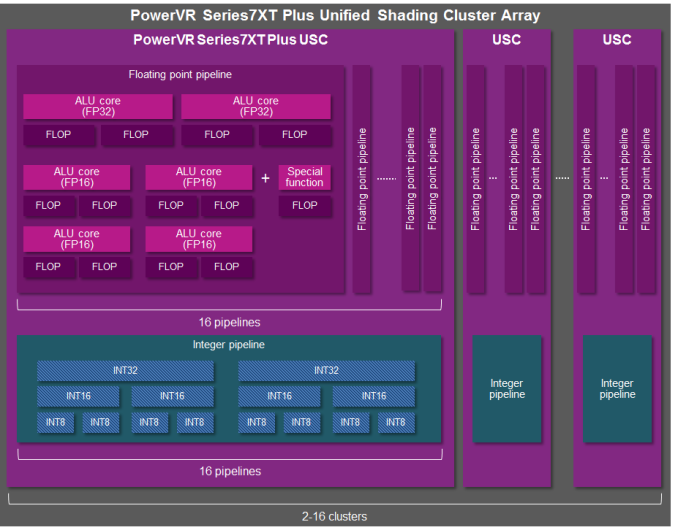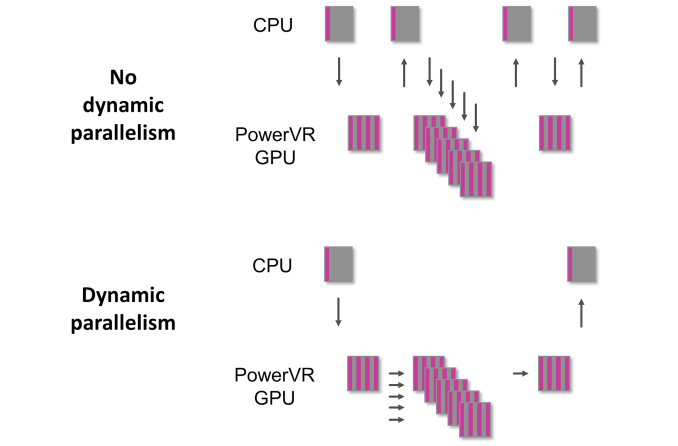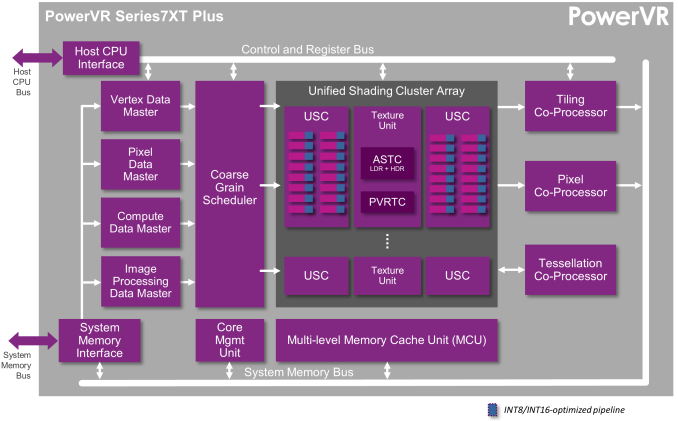Imagination Announces PowerVR Series7XT Plus Family - Rogue Gets Improved Compute
by Ryan Smith on January 6, 2016 10:00 AM EST- Posted in
- GPUs
- Mobile
- Imagination Technologies
- PowerVR
- CES 2016

A regular sight at CES at most years is a new PowerVR graphics announcement from the crew over at Imagination, and this year is no exception. Shortly before CES last year we were introduced to the company’s PowerVR Series7XT family, a significant iteration on their base Rogue architecture that added full support for the Android Extension Pack to their GPUs, along with specific improvements to improve energy efficiency, overall graphics performance, and compute performance. Imagination also used Series7XT to lay the groundwork for larger designs containing more GPU clusters, giving the architecture the ability to scale up to a rather sizable 16 cores.
After modernizing Rogue’s graphics capabilities with Series7XT, for their follow-up Imagination is taking a slightly different path. This year they are turning their efforts towards compute, with while also working on energy and memory efficiency on the side. To that end the company is using CES 2016 to announce the next iteration of the Rogue architecture, PowerVR Series7XT Plus.
With Series7XT Plus, Imagination is focusing first and foremost on improving Rogue’s compute performance and compute capabilities. To accomplish this they are making two important changes to the Rogue architecture. First and foremost, Imagination is upgrading Rogue’s integer ALUs to more efficiently handle smaller integer formats.
Though Imagination hasn’t drawn out the integer ALUs in previous generations’ architecture diagrams, the architecture has always contained INT32 ALUs. What has changed for Series7XT then is how those ALUs handle smaller INT16 and INT8 formats. Previously those formats would be run through the integer ALUs as INT32s, which though practical meant that there were few performance gains from using smaller integers since they weren’t really processed as smaller numbers. Series7XT Plus significantly changes this: the integer ALUs can now combine operations into a single operation based on their width. One ALU can now process 1 INT32, 2 INT16s, or 4 INT8s.
Imagination’s press release doesn’t offer a ton of detail in how they are doing this, however I suspect that they have gone with the traditional (and easiest) method, which is to simply bundle like-operations. An example of this would be bundling 4 INT8 adds into what is essentially one large INT32 addition operation, an action that requires minimal additional work from the ALU. If this is the case then the actual performance gains from using and combining smaller operations will depend on how often these operations are identical and can be bundled, though since we’re talking about parallel computing, it should be the case quite often.
From an architecture perspective this is an interesting and unexpected departure from Imagination’s usual design. One of the traditional differences between PowerVR and competitor ARM’s Mali designs is that Imagination went with dedicated FP16 and FP32 ALUs, whereas ARM would combine operations to fill out a 128-bit SIMD. The dedicated ALU approach has traditionally allowed for greater power efficiency (your ALUs are simpler), but it also means you can end up with ALUs going unused. So for Imagination to go this route for integers is surprising, though I suspect the fact that integer ALUs are simpler to begin with has something to do with it.
As for why Imagination would care about integer performance, this brings us back to compute workloads. Rather like graphics, not all compute workloads require full INT32/FP32 precision, with computer vision being the textbook example for compute workloads. Consequently, by improving their handling of lower precision integers, Imagination can boost their performance in these workloads. For a very low precision workload making heavy use of INT8s, the performance gains can be up to 4x as compared to using INT32s on Series7XT. Pragmatically speaking I’m not sure how much computer vision work that phone SoCs will actually be subjected to – it’s still a field looking for its killer apps – but at the same time from a hardware standpoint I expect that this was one of the easier changes that Imagination could make, so there’s little reason for Imagination not to do this. Though it should also be noted that Rogue has far fewer integer ALUs than FP ALUs - there is just 1 integer pipeline per USC as opposed to 16 floating point pipelines - so even though smaller integers are now faster, in most cases floating point should be faster still.
Update: Imagination has sent over a newer USC diagram, confirming that there are two integer ALUs per pipeline (with 16 pipelines) rather than just a total of two ALUs per USC.
Moving on, along with augmenting their integer ALUs, Imagination is also bringing OpenCL 2.0 support to their GPUs for the first time with Series7XT Plus. Previous PowerVR parts were only OpenCL 1.2 capable, so for Imagination 2.0 support is a big step up, and one that required numerous small changes to various areas of the Rogue architecture to support 2.0’s newer features.
We’ve already covered OpenCL 2.0 in depth before, so I won’t go too deep here, but for Imagination the jump to OpenCL 2.0 will bring them several benefits. The biggest change here is that OpenCL 2.0 adds support for shared virtual memory (and pointers) between CPU and GPU, which is the cornerstone of heterogeneous computing. Imagination of course also develops the MIPS architecture, so they now have a very straightforward path towards offering customers a complete heterogeneous computing environment if they need one. Otherwise from a performance perspective, OpenCL 2.0’s dynamic parallelism support should improve compute performance in certain scenarios by allowing compute kernels to directly launch other compute kernels. This ultimately makes Imagination just the second mobile SoC vendor to announce support for OpenCL 2.0, behind Qualcomm and the Adreno 500 series.
Aside from compute improvements, for Series7XT Plus Imagination has also made some smaller general improvements to Rogue to further improve power efficiency. Of particular note here is the Image Processing Data Master, a new command processor specifically for 2D workloads. By routing 2D operations through this simpler command processor, Imagination can save power by not firing up the more complex pixel/vertex data masters, making this another example of how mobile GPUs have slowly been adding more dedicated hardware as the power is more important than the die size cost. Meanwhile Imagination’s press release also notes that they have made some memory system changes, including doubling the memory burst size to match newer fabrics and components (presumably this is an optimization for DDR4), and tweaking the caches and their respective sizes to reduce off-chip memory bandwidth needs by 10% or so.
Overall these efficiency changes don’t appear to be as extensive as what we saw with Series7XT – and Imagination isn’t treating them as nearly as big of a deal – so the jump from Series7XT to Series7XT Plus shouldn’t be as great as what came before. Series7XT Plus in that regard is definitely a more incremental upgrade of Rogue, with Imagination focusing on improving a few specific use cases over the last year.
| PowerVR GPU Comparison | |||||
| Series7XT Plus | Series7XT | Series6XT | |||
| Clusters | 2 - 16 | 2 - 16 | 2 - 8 | ||
| FP32 FLOPS/Clock | 128 - 1024 | 128 - 1024 | 128 - 512 | ||
| FP16 Ratio | 2:1 | 2:1 | 2:1 | ||
| INT32 OPS/Clock | 128 - 1024 | 128 - 1024 | 128 - 512? | ||
| INT8 Ratio | 4:1 | 1:1 | 1:1 | ||
| Pixels/Clock (ROPs) | 4 - 32 | 4 - 32 | 4 - 16 | ||
| Texels/Clock | 4 - 32 | 4 - 32 | 4 - 16 | ||
| OpenGL ES | 3.2 | 3.2 | 3.1 | ||
| Android Extension Pack / Tessellation | Yes | Yes | Optional | ||
| OpenCL | 2.0 | Base: 1.2 EB Optional: 1.2 FP |
1.2 EB | ||
| Architecture | Rogue | Rogue | Rogue | ||
Finally, along with announcing the overarching Series7XT Plus family and its architecture, Imagination is also announcing two initial GPU designs for this family: GT7200 Plus and GT7400 Plus. As alluded to by their names, these are Series7XT Plus versions of the existing two-cluster GT7200 and four-cluster GT7400 designs. That imagination is only announcing smartphone designs is a bit odd – both of these designs are smaller than the GT7600 used in number-one customer Apple’s A9 smartphone SoC – though as Apple is the only customer using such a large design in a phone, for Imagination’s other customers these designs are likely more appropriate.
In any case, while Imagination does not formally announce when to expect their IP to show up in retail products, if history is any indicator, we should be seeing Seires7XT Plus designs by the end of this year and leading into 2017.
Source: Imagination













35 Comments
View All Comments
name99 - Saturday, January 30, 2016 - link
When the mythical ARM Mac arrives ...(Maybe at 10nm we'll see an A11P [three cores, 3GHz] and an A11D [6 cores, 3.5GHz] for running Macs:-) One day it will happen. Why not in 2017 or 2018? :-) )
ToTTenTranz - Wednesday, January 6, 2016 - link
7th paragraph:"Though it should also be noted that Rouge has far fewer integer ALUs than FP ALUs"
"Rouge" would indeed be a far classier name for the architecture, but you probably meant "Rogue".
hyno111 - Wednesday, January 6, 2016 - link
I suddenly forgot which company is using high-end ImgTec GPU on Android...lucam - Wednesday, January 6, 2016 - link
Good question!!extide - Wednesday, January 6, 2016 - link
I don't think anyone is. Intel uses ImgTec in the Phone targeted Atom's, but pretty much everyone else uses Mali, and then there is Qualcomm using their own Adreno.extide - Wednesday, January 6, 2016 - link
I forgot to mention, the ImgTec designs that Intel uses in the phone-Atom's are typically not large implementations either, which is kind of a shame.lucam - Wednesday, January 6, 2016 - link
Totally agree! Franky I would like to see more high end solutions from IMG implemented into android phones/tablets this year...LiverpoolFC5903 - Thursday, January 7, 2016 - link
The g6430 used in the Atom Z3580 is plenty fast for anything out there in the android universe. It matches 330 in most metrics and even outperforms it.The 330 is the 'gold standard' for smartphone GPUs and is still good enough to handle anything and everything.
BurntMyBacon - Thursday, January 7, 2016 - link
@LiverpoolFC5903: "The g6430 used in the Atom Z3580 is plenty fast for anything out there in the android universe."Doesn't mean I don't want faster. Frankly speaking, nothing I've played on android has been all that impressive to me. Also, the Z3580 is not limited to just android.
"The 330 is the 'gold standard' for smartphone GPUs and is still good enough to handle anything and everything. "
I could argue the merit of the statement, but I'll simply ask how long you want it to remain your "gold standard". Put a different way, how long do you want smartphone applications to be limited to the performance levels of the 330?
LiverpoolFC5903 - Friday, January 8, 2016 - link
That is because Android developers have to be cognizant of the fact that 90% plus android devices are low/lower mid range with low end processors/gpus. In order to maximize sales/downloads, they have to develop for the lowest common denominator or face miniscule adoption levels.I would love smartphone games to be as good as their console and PC cousins, but the fact of the matter is very few users (relatively speaking) have access to cutting edge hardware. The Adreno 320 rev2 in the SD 600 came out like 3 years ago, but can run almost every game even now (about 85 gflops).